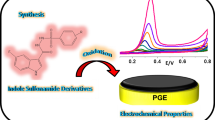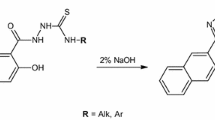Abstract
The aromatic/heteroaromatic sulfonylhydrazone derivatives as indole-3-carboxaldehyde methanesulfonylhydrazone (1), indole-3-carboxaldehydeethanesulfonyl hydrazone (2), thiophene-2-carboxaldehydeethanesulfonylhydrazone (3), 2-hydroxybenzaldehydeethanesulfonyl hydrazone (4), 2-hydroxyacetophenoneethanesulfonylhydrazone (5) and 2-hydroxy-1-naphth aldehydeethane sulfonylhydrazone (6) were synthesized by the reaction of sulfonic acids with aromatic/heteroaromatic aldehydes and characterized by using elemental analysis, 1H–13C NMR, LC–MS and IR spectra. The electrochemical behavior of the sulfonylhydrazones in DMSO at glassy carbon electrode was investigated using cyclic voltammetry, controlled potential electrolysis and chronoamperometry techniques. The number of electrons transferred, diffusion coefficient and standard heterogeneous rate constants were determined using electrochemical methods. Antimicrobial activities of the compounds 1–6 were tested against some microorganisms. The biological activity screening showed that compound 6 exhibited better activity than the others. Structure–activity relationship analysis of the sulfonylhydrazone derivatives was performed to explain the trend of activity with molecular descriptors. The indicator descriptors for compound 6 having naphtyl ring are the most important descriptos that are sensitive both to the size and electrophility of the molecules.







Similar content being viewed by others
References
Aleksic M, Kapetanovic V, Zuman P (2004) Polarographic and Voltammetric Behavior of the Antibiotic Cefetamet; reduction of the Methoxyimino group. Collect Czech Chem Commun 69:1429–1442
Alyar S, Karacan N (2009) Synthesis, characterization, antimicrobial activity and structure–activity relationships of new aryldisulfonamides. J Enzyme Inhib Med Chem 24:986–992
Alyar S, Karacan N, Özbek N, Kuzukıran K (2011a) Quantitative structure–activity relationships studies for prediction of antimicrobial activity of synthesized disulfonamide derivatives. Med Chem Res 20:175–183
Alyar S, Zengin H, Özbek N, Karacan N (2011b) Synthesis, characterization, spectroscopic properties, theoretical calculation and antimicrobial activity of new aryldisulfonamides. J Mol Struct 992:27–32
Alyar H, Alyar S, Ünal A, Özbek N, Şahin E, Karacan N (2012a) Synthesis, characterization and antimicrobial activity of m-toluenesulfonamide, N,N′-1,2-ethanediylbis (mtsen) and [Cu(II)(phenanthroline)2]mtsen complex. J Mol Struct 1028:116–125
Alyar H, Ünal A, Ozbek N, Aylar S, Karacan N (2012b) Conformational analysis, vibrational and NMR spectroscopic study of the methanesulfonamide-N,N’-1,2-ethanediylbis. Spectrochim Acta A 91:39–47
Asiri AM (2000) (Indol-3-yl)barbituric acid. Molecules 5:M183
Aslan HG, Özcan S, Karacan N (2012) The antibacterial activity of some sulfonamides and sulfonyl hydrazones, and 2D-QSAR study of a series of sulfonylhydrazones. Spectrochim Acta A 98:329–336
Bacon N, Boulton AJ, Brownlee RTC, Katritzky AR, Topsom RD (1965) Infrared absorption of substituents in heterocyclic systems. Amine–imine tautomerism by infrared spectroscopy. J Chem Soc Part IX:5230–5233
Bajaj S, Sambi SS, Madan AK (2005) Prediction of anti-inflammatory activity of N-arylanthranilic acids: computational approach using refined Zagreb indices. Croat Chem Acta 78:165–174
Balaban A, Sekerci M, Erk B (2003) Synthesis, physico-chemical characterization, and stability constants of metal complexes of pyridine-2-carbaldehyde thiosemicarbazone. Synth React Inorg Met-Org Chem 33:1775–1786
Balaban A, Çolak N, Ünver H, Erk B, Durlu TN, Zengin DM (2008) Synthesis, spectroscopic studies and crystal structure of N,N′-bis((thiophene-2-carboxamido)propyl)piperazine. J Chem Cryst 38:369–372
Baymak MS, Celik H, Lund H, Zuman P (2003) Contribution to electroreduction of hydrazones. Electrochem Soc 12:94–96
Çete S, Dişli A, Yıldırır Y, Yaşar A (2006) Synthesis and antimicrobial effects of some phenylazopropanedinitriles and their derivatives. Asian J Chem 18:2061–2066
de Souza MVN (2005) Synthesis and biological activity of natural thiazoles: an important class of heterocyclic compounds. J Sulfur Chem 26:429–449
Demirel Özel A, Durmuş Z, Çukurovalı A, Yılmaz İ, Kılıç E (2009) Electroreduction of some substituted hydrazones on platinum electrode in dimethylformamide. Acta Chim Slovencia 56:797–806
Dodoff NI, Özdemir Ü, Karacan N, Gorgieva M, Konstantinov SM, Stefanova ME (1999) Schiff bases of methanesulfonylhydrazine. Synthesis, spectroscopic characterization, conformational analysis and biological activity. Z Naturforsch 54:1553–1562
Faniran JA, Patel KS, Bailar JC (1974) Infrared spectra of N,N′-bis(salicylidene)-1,1-(dimethyl)ethylenediamine and its metal complexes. J Inorg Nucl Chem 36:1547–1551
Finlay GJ, Baguley BC, Snow K, Judd W (1990) Multiple patterns of resistance of human leukemia cell sublines to amsacrine analogues. Natl Cancer Inst 82:662–667
Hamurcu F, Balaban Gündüzalp A, Çete S, Erk B (2008) The synthesis, characterization and antimicrobial activity of N,N′-bis(2-thiophenecarboxamido)-1,3-diaminopropane and N,N′-bis(2-furancarboxamido)-1,3-diaminopropane and their Cu(II), Zn(II), Co(III) complexes. Trans Met Chem 33:137–141
Jensen PB, Sorensen BS, Demant EJ, Sehested M, Jensen PS, Vindelov L, Hansen HH (1990) Antagonistic effect of aclarubicin on the cytotoxicity of etoposide and 4′-(9-acridinylamino)methanesulfon-m-anisidide in human small cell lung cancer cell lines and on topoisomerase II-mediated DNA cleavage. Cancer Res 50:3311–3316
Karacan MS, Yakan Ç, Yakan M, Karacan N, Zharmukhamedov SK, Shitov A, Los DA, Klimov VV, Allakhverdiev SI (2012) Quantitative structure–activity relationship analysis of perfluoroiso-propyldinitrobenzene derivatives known as photosystem II electron transfer inhibitors. Biochim Biophys Acta 1817:1229–1237
Katircioglu H, Beyatlı Y, Aslim B, Yuksekdağ Z, Atici Z (2006) Screening for antimicrobial agent production of some microalgae in freshwater. Internet J Microbiol 2(2):1–9
Katritzky AR, Jones RA (1960) Infrared absorption of substituents in aromatic systems. Part VI. Methanesulphonamides. J Chem Soc 4497–4499
Keskioğlu E, Balaban Gündüzalp A, Çete S, Hamurcu F, Erk B (2008) Cr(III), Fe(III) and Co(III) complexes of tetradentate (ONNO) Schiff base ligands: synthesis, characterization, properties and biological activity. Spectrochim Acta A 70:8634–8640
Klingler RJ, Kochi JK (1981) Electron-transfer kinetics from cyclic voltammetry. Quantitative description of electrochemical reversibility. J Phys Chem 85:1731–1741
Lenco A, Mealli C, Paoli P, Dodoff N, Kantarcı Z, Karacan N (1999) Structure and vibrational spectroscopy of methanesulfonic acid hydrazide: an experimental and theoretical study. New J Chem 23:1253–1256
Nicholson RS, Shain I (1964) Theory of stationary electrode polarography: single scan and cyclic methods applied to reversible, irreversible and kinetic systems. Anal Chem 36:706–723
Özbek N, Katırcıoğlu H, Karacan N, Baykal T (2007) Synthesis, characterization and antimicrobial activity of new aliphatic sulfonamide. Bioorg Med Chem 15:5105–5109
Özbek N, Aylar S, Karacan N (2009) Experimental and theoretical studies on methanesulfonic acid 1-methylhydrazide: antimicrobial activities of its sulfonyl hydrazone derivatives. J Mol Struct 938:48–53
Özbek N, Aylar S, Mamaş S, Şahin E, Karacan N (2012) Synthesis, crystal structure, antibacterial activities, and electrochemical studies of new N,N′-polymethylene bis-sulfonamides. J Mol Struct 1010:1–7
Özçelik S, Dinçer M, Şekerci M, Balaban A, Özdemir Ü (2004) N-Phenyl-N-(2-thienylmethylene)hydrazine. Acta Crystallogr Sect E 60:1552–1553
Özdemir Özmen Ü, Olgun G (2008) Synthesis, characterization and antibacterial activity of new sulfonyl hydrazone derivatives and their nickel(II) complexes. Spectrochim Acta A 70:641–645
Özdemir Ü, Sentürk OS, Sert S, Karacan N, Ugur F (2003) Photochemical reactions of metal carbonyls [M(CO)6 (M Cr, Mo, W), Re(CO)5Br, Mn(CO)3Cp] with 2-hydroxyacetophenone methanesulfonylhydrazone (apmsh). Trans Met Chem 28:443–446
Özdemir Ü, Karacan N, Şentürk OS, Sert S, Uğur F (2004) Synthesis and characterization of metal carbonyl complexes of M(CO)(6)(M Cr, Mo, and W), Re(CO)(5)Br, and Mn(CO)(3)CP with-acetone methanesulfonylhydrazone (amsh) and methanesulfonylhydrazone (msh). Synth React Inorg Met-Org Chem 34:1057–1067
Özdemir Ü, Şentürk OS, Sert S, Karacan N, Uğur F (2006) Reaction of metal carbonyls with 2-hydroxy-1-napthaldehyde methanesulfonylhydrazone and characterization of the substitution products. J Coord Chem 59:1905–1911
Özdemir Ü, Güvenç P, Şahin E, Hamurcu F (2009) Synthesis, characterization and antibacterial activity of new sulfonamide derivatives and their nickel(II), cobalt(II) complexes. Inorg Chim Acta 362:2613–2618
Özdemir Ü, Arslan F, Hamurcu F (2010) Synthesis, characterization, antibacterial activities and carbonic anhydrase enzyme inhibitor effects of new arylsulfonylhydrazone and their Ni(II), Co(II) complexes. Spectrochim Acta A 75:121–126
Özdemir ÖÜ, Akkaya N, Özbek N (2013) New Ni(II), Pd(II), Pt(II) complexes with aromatic methanesulfonylhydrazone based ligands. Synthesis, spectroscopic characterization and in vitro antibacterial evaluation. Inorg Chim Acta 400:13–19
Percy GC, Thornton DA (1972) N-aryl salicylaldimine complexes: ınfrared and PMR spectra of the ligands and vibrational frequencies of their metal(II) chelates. Inorg Nucl Chem 34:3357–3367
Raman N, Kulandaisamy A, Shunmugasundaram A, Jeyasubramanian K (2001) Synthesis, spectral, redox and antimicrobial activities of Schiff base complexes derived from 1-phenyl-2,3-dimethyl-4-aminopyrazol-5-one and acetoacetanilide. Trans Met Chem 26:131–135
Rohrbaugh RH, Jurs PC (1987) Description of molecular shape applied in studies of structure/activity and structure/property relationships. Anal Chim Acta 199:99–109
Sert S, Senturk OS, Ozdemir U, Karacan N, Ugur F (2004) Synthesis and characterization of the products reaction of metal carbonyls[M(CO)6 (M Cr, Mo, W), Re (CO)5Br, Mn(CO)3Cp] with salicylaldehyde methanesulfonyl-hydrazone. J Coord Chem 57:183–188
Teyssie P, Charette JJ (1963) Physico-chemical properties of co-ordinating compounds-III: infra-red spectra of N-salicyclidenealkylamines and their chelates. Spectrochim Acta A 19:1407–1423
Vance AL, Alcock NW, Heppert JA, Busch DH (1998) An octahedral template based on a new molecular turn: synthesis and structure of a model complex and a reactive, diphenolic ligand and its metal complexes. Inorg Chem 37:6912–6920
Acknowledgments
This research was supported by Gazi University Research Found under Project No. 05/03-15. The authors thank TUBİTAK for allocation of time at the 1H–13C-NMR, LCMS, and elemental analyses.
Author information
Authors and Affiliations
Corresponding author
Rights and permissions
About this article
Cite this article
Gündüzalp, A.B., Özmen, Ü.Ö., Çevrimli, B.S. et al. Synthesis, characterization, electrochemical behavior, and antimicrobial activities of aromatic/heteroaromatic sulfonylhydrazone derivatives. Med Chem Res 23, 3255–3268 (2014). https://doi.org/10.1007/s00044-013-0907-7
Received:
Accepted:
Published:
Issue Date:
DOI: https://doi.org/10.1007/s00044-013-0907-7




